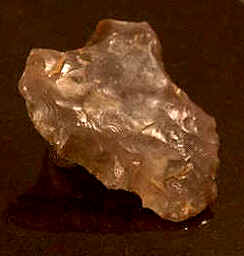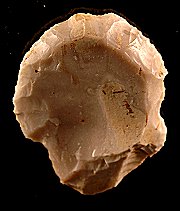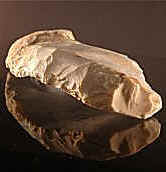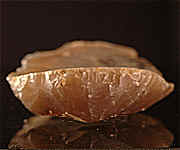| Re-touching
of flint tools
Re-touching
Re-touching of one or more edges is a sure sign of human
manufacture. Unfortunately it can sometimes be confused with edge
damage that has been caused by knocking against the plough or
other stones in the field. This is one reason why uniform patination is
important, since random damage will have differential levels of
patination. Edge damage tends to be random and discontinuous,
while retouching is usually continuous and even overlapping.
Flints were re-touched in a number of different ways for different
purposes. Shallow angle re-touching, sometimes called 'invasive'
retouching, was used for sharpening
further an already thin feather edge on knives, scrapers,
arrowheads and other weapons and tools. This process was
usually done by hand using the point of a piece of wood or antler
and is know as 'pressure flaking'.
Re-touching was also used at a steeper angle (usually between
45 and 90 degrees) to blunt or 'back off' a sharp edge to make a
tool easier to hold. This is referred to as 'abrupt'
or 'semi-abrupt re-touching'
Usually only a single side or end of a flake was re-touched,
making it into either a side scraper or end scraper. Less often a
flake was suitable for more extensive re-touching and would be
turned into a multi-purpose tool. Double side-scrapers, side
and end scrapers and even more elaborate tools with boring points.
The almost circular scraper pictured right has been re-touched
around virtually its entire circumference. The bottom two
pictures show a combined side and end scraper. The curved end has been
semi-abruptly re-touched
but in this case it is to provide a sharp edge.
Some forms of re-touching are exceptionally delicate. A
few toolmakers were so skilled they could strike a wafer thin
strip from the edge of a flake or blade, making it sharp as a
razor. In some cases, the pressure flaking has been done
with a point so fine that it almost needs a magnifying glass to
see it properly. This quality of work compares favourably with
that of a modern gemstone cutter.

Difficult to show adequately in a photo but every
part of the surface of this little flint (spear point?)
has been exquisitely re-touched.
|

Almost the whole circumference of this scraper has been
re-touched

One long edge of this side scraper has been blunted by semi-abrupt
re-touching

A combined side and end scraper

A closer view. The end of the scraper has been abruptly re-touched to form a sharp
edge, not to blunt it.
|